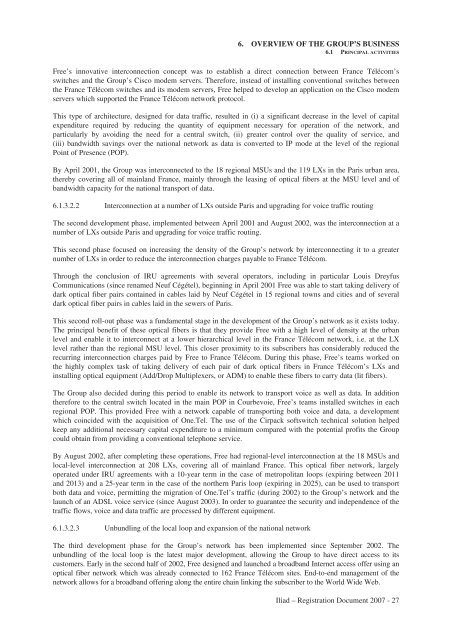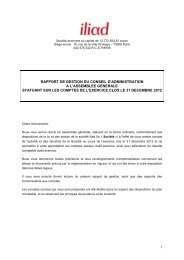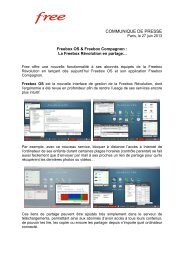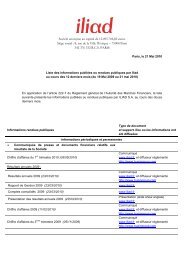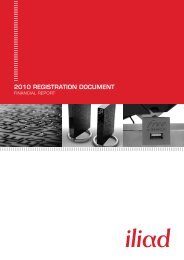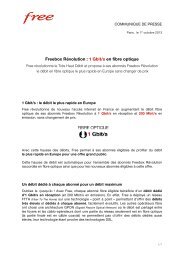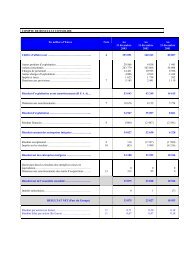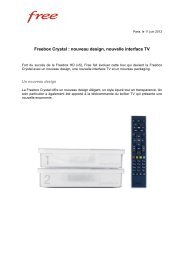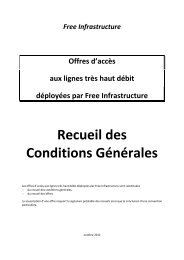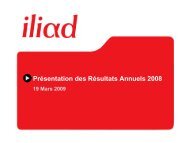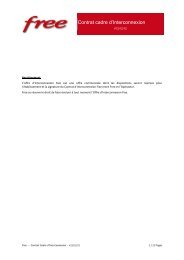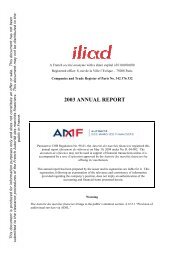REGISTRATION DOCUMENT AND FINANCIAL REPORT - Iliad
REGISTRATION DOCUMENT AND FINANCIAL REPORT - Iliad
REGISTRATION DOCUMENT AND FINANCIAL REPORT - Iliad
- TAGS
- registration
- iliad
- iliad.fr
You also want an ePaper? Increase the reach of your titles
YUMPU automatically turns print PDFs into web optimized ePapers that Google loves.
6. OVERVIEW OF THE GROUP’S BUSINESS<br />
6.1 PRINCIPAL ACTIVITIES<br />
Free’s innovative interconnection concept was to establish a direct connection between France Télécom’s<br />
switches and the Group’s Cisco modem servers. Therefore, instead of installing conventional switches between<br />
the France Télécom switches and its modem servers, Free helped to develop an application on the Cisco modem<br />
servers which supported the France Télécom network protocol.<br />
This type of architecture, designed for data traffic, resulted in (i) a significant decrease in the level of capital<br />
expenditure required by reducing the quantity of equipment necessary for operation of the network, and<br />
particularly by avoiding the need for a central switch, (ii) greater control over the quality of service, and<br />
(iii) bandwidth savings over the national network as data is converted to IP mode at the level of the regional<br />
Point of Presence (POP).<br />
By April 2001, the Group was interconnected to the 18 regional MSUs and the 119 LXs in the Paris urban area,<br />
thereby covering all of mainland France, mainly through the leasing of optical fibers at the MSU level and of<br />
bandwidth capacity for the national transport of data.<br />
6.1.3.2.2 Interconnection at a number of LXs outside Paris and upgrading for voice traffic routing<br />
The second development phase, implemented between April 2001 and August 2002, was the interconnection at a<br />
number of LXs outside Paris and upgrading for voice traffic routing.<br />
This second phase focused on increasing the density of the Group’s network by interconnecting it to a greater<br />
number of LXs in order to reduce the interconnection charges payable to France Télécom.<br />
Through the conclusion of IRU agreements with several operators, including in particular Louis Dreyfus<br />
Communications (since renamed Neuf Cégétel), beginning in April 2001 Free was able to start taking delivery of<br />
dark optical fiber pairs contained in cables laid by Neuf Cégétel in 15 regional towns and cities and of several<br />
dark optical fiber pairs in cables laid in the sewers of Paris.<br />
This second roll-out phase was a fundamental stage in the development of the Group’s network as it exists today.<br />
The principal benefit of these optical fibers is that they provide Free with a high level of density at the urban<br />
level and enable it to interconnect at a lower hierarchical level in the France Télécom network, i.e. at the LX<br />
level rather than the regional MSU level. This closer proximity to its subscribers has considerably reduced the<br />
recurring interconnection charges paid by Free to France Télécom. During this phase, Free’s teams worked on<br />
the highly complex task of taking delivery of each pair of dark optical fibers in France Télécom’s LXs and<br />
installing optical equipment (Add/Drop Multiplexers, or ADM) to enable these fibers to carry data (lit fibers).<br />
The Group also decided during this period to enable its network to transport voice as well as data. In addition<br />
therefore to the central switch located in the main POP in Courbevoie, Free’s teams installed switches in each<br />
regional POP. This provided Free with a network capable of transporting both voice and data, a development<br />
which coincided with the acquisition of One.Tel. The use of the Cirpack softswitch technical solution helped<br />
keep any additional necessary capital expenditure to a minimum compared with the potential profits the Group<br />
could obtain from providing a conventional telephone service.<br />
By August 2002, after completing these operations, Free had regional-level interconnection at the 18 MSUs and<br />
local-level interconnection at 208 LXs, covering all of mainland France. This optical fiber network, largely<br />
operated under IRU agreements with a 10-year term in the case of metropolitan loops (expiring between 2011<br />
and 2013) and a 25-year term in the case of the northern Paris loop (expiring in 2025), can be used to transport<br />
both data and voice, permitting the migration of One.Tel’s traffic (during 2002) to the Group’s network and the<br />
launch of an ADSL voice service (since August 2003). In order to guarantee the security and independence of the<br />
traffic flows, voice and data traffic are processed by different equipment.<br />
6.1.3.2.3 Unbundling of the local loop and expansion of the national network<br />
The third development phase for the Group’s network has been implemented since September 2002. The<br />
unbundling of the local loop is the latest major development, allowing the Group to have direct access to its<br />
customers. Early in the second half of 2002, Free designed and launched a broadband Internet access offer using an<br />
optical fiber network which was already connected to 162 France Télécom sites. End-to-end management of the<br />
network allows for a broadband offering along the entire chain linking the subscriber to the World Wide Web.<br />
<strong>Iliad</strong> – Registration Document 2007 - 27


